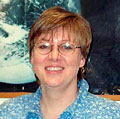 |
|
|
| Author |
Message |
Patty_Cie

Joined: 23 Mar 2004
Posts: 87

|
 Posted:
Fri Jun 18, 2004 4:29 pm Posted:
Fri Jun 18, 2004 4:29 pm |
  |
June 8, 2004 Tuesday
4:30 PM Alaska time
One of the fundamental questions of the Shelf Basin Interaction (SBI) project asks, “Is excess organic carbon produced on the biologically rich Arctic shelf being transported to the biologically poor Arctic basin?” Buried within this question is the assumption that the Arctic shelves produce excess organic carbon. Is the assumption correct? The world will soon know because microbial ecologists, Dave Kirchman from the University of Delaware, College of Marine Studies and his PhD student, Rex Malmstrom, are on the Healy investigating the question, “Is excess organic carbon produced in the Arctic water column?”
In the simplest terms, phytoplankton use photosynthesis to create organic carbon and oxygen. For every one carbon atom produced, there are two oxygen atoms released as a metabolic byproduct. The relationship between the carbon production and the release of oxygen allows Dave and Rex to measure oxygen production for their net carbon investigation.
In order to measure oxygen production they need to know two things: 1. The change in the oxygen levels over time and 2. How much oxygen organisms are using collectively. To measure the change in oxygen levels over time, Dave and Rex perform what they term the light bottle experiment. They collect water from the CTD containing primary producers and other microbes into 60-milliliter clear bottles. They immediately measure how much oxygen is in the water to establish a beginning oxygen concentration. The bottles are put into a screened incubator located on the ship’s bow to simulate the natural environment at the different depths where the water was collected.
Oxygen levels in the bottles rise because the primary producers are creating oxygen and it falls because the other biota are using oxygen. The scientist keep track of the oxygen changes by measuring oxygen levels from two to three bottles at three different time points over the run of the experiment. At the end of the experiment, Dave and Rex subtract the beginning oxygen concentration from the ending oxygen concentration to calculate the overall change in oxygen levels.
To measure how much oxygen the organisms are using collectively, Dave and Rex repeat the above experiment using dark instead of clear bottles and a dark, refrigerated room with temperature levels to imitate the natural environment rather than the bow incubator. By using dark bottles and a dark room, the scientists remove all possible light sources. In the absence of light, phytoplankton cannot photosynthesize and oxygen production stops. However, the other microbes do metabolize, therefore, the only oxygen change that can occur over time is oxygen use.
With the oxygen measurements from the light bottle and the dark bottle experiments, Dave and Rex have all the information they need to calculate net and gross primary production. The difference between the dark bottle’s total-oxygen used and the light bottle’s change in oxygen levels is how much oxygen the primary producers created. Using the relationship between oxygen created and carbon made, the scientists apply a mathematical formula and calculate the microbial production. If the net microbial production is positive, then the water column has excess carbon production that is available for transport to other locations such as the deep ocean basins and the SBI assumption will be validated.
Moreover, Dave and Rex are investigating how efficient bacteria grow. They use a technique created by Dave in 1985. First, they add 20 nm of radioactive leucine tracer to 1.5 ml of filtered water and then centrifuge the sample. (The sample is small because typically there are about a million bacteria per milliliter of seawater.) While the bacteria are incubating, they feed on dissolved organic carbon (DOC) and leucine, incorporating the chemicals into their bodies. After a set time, the scientists measure how much of the tracer is in the bacteria’s cell, thereby, telling how much DOC was consumed. By dividing the biomass production by the DOC consumption, the scientists calculate the bacterial growth efficiency.
Dissolved organic carbon is unavailable to the rest of the food web. However, DOC is the carbon source bacteria consume. Although they breathe most of the DOC away, some of carbon is used to make more bacteria. The bacteria offspring become an organic carbon food source other organisms can eat. Therefore, bacteria have a vital role in adding carbon to the food web by transforming an unusable form of carbon into a useable form.
In the more productive coastal water, particulate organic carbon is abundant and bacteria’s role in carbon exchange is reduced. However, in the open ocean, microbes are the major players in the food web. Remember, most of the ocean is open water! So in addition to measuring microbial production, Dave and Rex are also measuring how many bacteria exist in the water column.
Aboard the Healy, they fix a water sample with formaldehyde to harden the sample so the bacteria do not break up and become unusable. The sample is filtered using a 0.2-micron polycarbonate filter that has discrete holes to allow most of the viruses to pass, but captures the bacteria. The filter is mounted on a slide, sealed with a cover slip, and placed in a –20 degree Celsius freezer until it can be shipped back to their home university. At the university, the slides are placed on an epifluorescence microscope where the bacteria are counted by an image analysis system.
To see photographs taken by Steve Roberts of UCAR/JOSS, click here. |
|
|
    |
 |
|
|
|
View next topic
View previous topic
You cannot post new topics in this forum
You cannot reply to topics in this forum
You cannot edit your posts in this forum
You cannot delete your posts in this forum
You cannot vote in polls in this forum
You cannot attach files in this forum
You can download files in this forum
|
Powered by phpBB 2.0.11
© 2001, 2002 phpBB Group :: FI Theme ::
All times are GMT
| |
